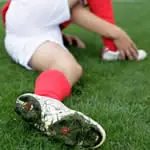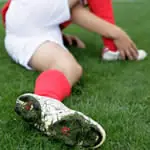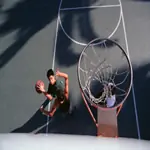Examples
Each of the following dynamic warm-up exercises should be done for the length of half of a basketball court and can be followed with a light jog back to the starting point to guarantee the warm up effect is not lost. When designing the day’s dynamic warm-up, try to incorporate exercises that address all of the body’s muscle groups fairly evenly (hamstrings, quadriceps, calves/Achilles, and hip flexors). Also try to use as much variety and creativity as possible to keep the players interested and prevent them from becoming complacent during the warm-up. Choose 4-6 of the following dynamic stretches each workout.
- Ankle Pops: Lightly bounce off the toes while keeping the knees in a very slight bend. The goal is to progressively get more range of motion towards the end of the prescribed distance. This motion looks very similar to jumping rope except you will be moving progressively forward.
- High Knees: Basic running form with the addition of bringing the knees up higher than normal; make sure to move your feet as quickly as possible and aim to get your knees higher than your waistline. Important to keep your ankles, knees, hips, and shoulders facing the direction you are running.
- Butt Kicks: Similar concept to high knees except you keep your thighs perpendicular to the ground and you kick your heels up towards your backside (again; move your feet as quickly as you can). Like above, keep your ankles, knees, hips, and shoulders facing the direction you are running.
- Carioca: Moving laterally to your left, cross your right foot in front--then step with your left--then cross your right foot behind and repeat. Aim to get as much hip rotation as possible and get those feet moving quickly. If done correctly this looks like a new dance move.
- Step Slide: Assume a low athletic position with your feet slightly wider than shoulder-width. Slowly step with your lead leg while keeping the body in a low position. You should stay low and keeping a minimum of six inches in distance between the feet upon returning to the original position. This is similar to a "defensive slide" in basketball.
- Glute Walk: In the process of your walk, put your left hand on your left knee and right hand on your left ankle. From there pull both your knee and ankle in towards your chest. Take a step and repeat on the other leg.
- Back Pedal: Run backwards keeping a little bit of a forward lean (shoulders over your toes) to prevent falling. Really “reach” back as far as you can with each step to help stretch the hip flexor muscles.
- Frankenstein March: Keeping your left leg straight, kick your left leg up in front of you as high as you can and try to touch your opposite arm’s finger tips–basically a straight leg march–and then repeat with the right leg. This is an excellent way to increase hamstring flexibility.
- Knee Hug: While walking forward, hug your left knee into your chest, then step and do the same thing with your right leg (then repeat again with your left). This is an excellent way to loosen up the glutes and hips.
- Pointers: Keeping your left leg straight (and right leg bent) and left foot pointed upwards; reach down with your right hand try to touch your left toe. Then take a step and repeat with the other side. This is another excellent movement to increase hamstring and low back flexibility.
- Quad Walk: While walking forward, pull your left heel into your butt, then step and do the same thing with your right leg (alternating each leg). This is ideal for loosening up the quadriceps and hip flexors.
- Low Lunge: Step forward with your left leg into a lunge position (ankles, knees, hips and shoulders square to where you are facing; torso upright); try and place your left elbow on the ground as close to your left heel as you can.
- Over the Fence: Facing opposite of the way you are going; raise your left knee up as high as you can and rotate it behind you as if you were trying to walk backwards and step over an imaginary fence. Then do the same thing with the right leg (alternating each leg).
- Inchworm: Assume a push-up position on the ground. Walk your feet close to your hands while keeping the legs as straight as possible. From this position, then walk your hands back out to the original pushup position. Repeat for the prescribed distance. Your hands and feet should never leave the ground when performing this exercise.
- Scorpion: Lie face down on the ground with your arms extended out to your sides and palms facing down. Drive your left heel towards your right hand while keeping your right glute and shoulder on the ground. During this process, squeeze your left glute, and attempt to keep your shoulders flat while reaching the left foot towards the hand. Repeat this move on the opposite leg.
As with any drill, it is important to start out conservative and slow until a player has mastered the movement with perfect technique. For drills such as "high knees" an athlete can certainly increase speed as they become more proficient at performing the movement. For drills such as "pointers" speed should be kept slow and controlled with improving range of motion as the primary focus. The entire dynamic warm-up can be done in as little as 5 minutes or take as long as 20 minutes depending on the goals, age, and fitness level of the group you are working with.
- 2
- of
- 2







Discuss This Article